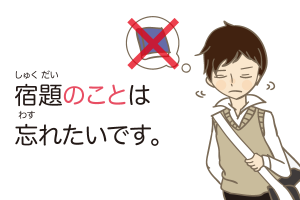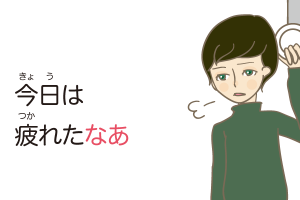Last time, you learned how the generic nouns: もの and こと work, e.g. “ケイスケのことをよく知っています (I know about Keisuke a lot).” You might consider のこと as a kind of a suffix. That is to say, by attaching のこと to nouns, you can express additional meanings. In this lesson, you will learn more about prefixes and suffixes.
Explanation for How Japanese Prefixes and Suffixes Work
| Table of Contents Change (or Add) Meanings Change Parts of Speech |
The difference between prefixes and suffixes are their positions, i.e. if you place something before words, it’s called a “prefix” and if you place it after words, it’s called a “suffix.” The functions can be divided into two groups. The first is to change (or add) meanings and the second is to change parts of speech, e.g. from nouns to adjectives. That sounds useful, doesn’t it? Let’s learn how they work one by one. Note: we cannot pick up every prefix and suffix here. Please learn them by yourself after grasping the basic concept.
Change (or Add) Meanings
The usage is relatively easy. If there is kanji, you can figure out meanings by utilizing the characteristic kanji has. You cannot connect prefixes or suffixes with all words. You need to memorize combinations depending on the context.
未… Undone
| 未解決: unsettled | 未成年: minor | 未経験: inexperience | 未発達: undeveloped |
| 未完成: incompletion | 未開封: unopened | 未公開: unpublished | 未使用: unused |
無… Zero
| 無意味: nonsense | 無罪: innocence | 無意識: unconsciousness | 無関心: indifferent |
| 無関係: unrelated | 無責任: irresponsibility | 無条件: unconditional | 無制限: limitless |
反… Anti
| 反政府: anti-government | 反比例: inverse proportion | 反物質: antimatter |
不… / 非… Negative
| 不自由: disability | 不規則: irregularity | 不景気: recession |
| 非公式: informal | 非合法: illegal | 非公開: private |
The above examples are closer to vocabulary rather than grammar. We think that you can use them without a specific explanation.
…達, …ども, …方 and …ら: Plurality
私達: we (neutral)
私ら: we (casual)
私ども: we (humble)
あなた方: you (honorific)
Four of them are used with nouns which indicate people and indicate plurality. The point here is that ども can make people’s position low, that is to say, you can even use ども to insult people like “政治家どもが全然仕事をしない (the f—king politicians don’t work at all).” By contrast, 方 can make people’s position high. Thus, it will sound weird if you use 方 to those who belong to your community like 子供方. It should be 子供達.
…料, …費, …賃 and …代: Money Related Suffixes
| 食費: food expense | 交通費: travel expense | 会費: membership fee |
| レッスン料: lesson fee | 講演料: lecture fee | 郵送料: postage |
| 電車賃: train fare | 家賃: rent fee | 手間賃: wage for labor |
| 電車代: train fare | 電気代: electricity rate | 修理代: cost of repair |
English has several words which indicate money, e.g. fare, fee, and expense. Japanese also has several. Unfortunately, they are not completely equivalent. 費 is close to “expense” and “cost” and used with nouns which indicate activities and facilities. 料 is close to “fee” and used with nouns which indicate services. 賃 has a narrow usage and is used with transportation service or in a set phrase like “家賃: rent fee”. By contrast, 代 has a wide usage and is used with nouns which indicate activities, facilities, services, and transportation. 代 can sometimes be replaced with 料 and 賃.
…中, …時, and …代: Time-Related Suffixes
| 明日中: within tomorrow | 仕事中: during working | 一日中: throughout the day |
| 練習時: when practicing | 通勤時: when commuting | 混雑時: when crowed |
| 1950年代: 1950s | 十代: teenage |
中 has three functions. The first is to indicate deadline like “by” and “within.” The second is to indicate “periods of ongoing actions.” 仕事中 and 仕事をしている間 have the almost same meaning. The third is to work as a temporal adverb which indicates “throughout.” 一日中 and 一日を通じて have the almost same meaning. 時 is used with nouns which indicate actions or states, and works like “通勤する時.” 代 indicates generations and is generally used with years and ages.
[adsense]
Change Parts of Speech
In general, only suffixes have the function to change parts of speech. This usage is a little more difficult than the first one because some of them require conjugation.
…的 and …らしい: From Nouns to Adjectives
| 実践的な研修(だ / です)。 [It] is practical training. |
| この絵は芸術的(だ / です)。 This picture is artistic. |
| イチローは全国的に有名(だ / です)。 Ichiro is famous nationwide. |
…的 changes nouns to na-adjectives. It can be also used in the state-of-being style or as an adverb. You can roughly consider 的 as the counterpart to “-like” in English. For example, “禅: zen” is a noun and can be an adjective like this “禅的な: zen-like.” Note: 禅 is a religious word in Japanese and used in a different way from zen in English. This example is just for the sake of the explanation.
| 学生らしい服装(だ / です)ね。 [Your] clothes are just like a student’s, aren’t they? |
| 細かいのは研究者らしい(です)ね。 Being careful is just like a researcher. |
| 学生らしく挑戦(しよう / しましょう)。 Let’s try [it] just like a student. |
…らしい changes nouns to i-adjectives and indicates their typical characteristics. You may consider “like” is the counterpart in English. With the third example above, we have further conjugated it into an adverb, i.e. らしい => らしく.
…がる: From Adjectives to Verbs
| ボブは足を痛がって(いる / います)。 Bob has pain in his foot. |
| ボブは足を痛い(です)。 => Wrong |
| 子供は注射を(嫌がる / 嫌がります)。 Children dislike injections. |
| 田中さんは新しいものばかり欲しが(る / ります)。 Tanaka-san wants only new items. |
…がる changes adjectives of emotions to verbs. The conjugation is to replace the last い of i-adjectives with がる and to attach がる to na-adjectives instead of な. As you learned, you cannot use adjectives of emotions with other people because you cannot exactly know how they feel. …がる is the suffix that allows you to do so. When you describe ongoing states, you need to use the te-form + いる. When you describe constant states like the third and fourth examples, you use the plain form.
…さ: Adjectives to Nouns
優しさ: kindness
丈夫さ: robustness
広さ: largeness, area
高さ: highness, height
…さ is the counterpart to “-ness” in English and changes adjectives to nouns. The conjugation is to replace the last い of i-adjectives with さ and to attach さ to na-adjectives instead of な. After changing, some of them will have a new meaning (*the third and fourth examples). Although you can connect most of the i-adjectives with さ, some of the na-adjectives cannot be connected. For example, you cannot use na-adjectives which end with 的.
…方 and …よう: Verbs to Nouns
考え方: way of thinking
考えよう: way of thinking (manner)
食べ方: way of eating
食べよう: way of eating (manner)
寿司の食べ方: way of eating Sushi
駅への行き方: way of going to the station
You can change verbs into nouns by attaching 方 or よう to the polite form instead of です. 方 comes from the word “方法: way” while よう comes from the word “様子: manner.” Therefore, both of them can indicate “way of doing.” Verbs with objects can also become nouns. In that case, the particle の or a combined particle will have an important role. Be careful, however, よう cannot be used in the context which indicates procedures or methods.
| 言い方・言いよう によって、「あげる」は失礼に(なる / なります)。 Depending the way of saying, ageru will sound rude. |
| 絵の 描き方・ Please teach me how to paint pictures. |
…上: Nouns to Adverbs
事実上: virtually
計算上: computationally
職業上: from one’s professional point of view
教育上: from an educational point of view
…上 is generally used with words which have their origins in Chinese and change nouns to adverb. Some of them have the counterpart in English like the first and second example above. If there is no counterparts, you can consider …上 indicates something like “from Noun’s point of view” or “as a Noun.”
| この会社は事実上、倒産して(いる / います)。 This company is virtually bankrupt. |
| 教育上、漫画の読み過ぎはよく(ない / ありません)。 Reading manga in excess is not good from an educational point of view. |
…っぽい: Tendency
| 子供は飽きっぽい(です)。 Children tend to get bored |
| 子供っぽいことはしないで(ください)。 Don’t do something childish. |
| 高級っぽい腕時計(だ / です)ね。 [It] is a high-class looking watch, isn’t it? |
| 安っぽい味が(する / します)。 [It] tastes cheap. |
This is an exception. っぽい can connect with verbs, nouns, na-adjectives, and i-adjectives. The conjugation is to attach っぽい to the plain form of verbs instead of ます, to just attach っぽい to nouns, to attach っぽい to na-adjectives instead of な, and to replace the last い of i-adjectives with っぽい. After the conjugations, it will work as an i-adjective.
Regarding the function, when you connect っぽい with verbs which indicate change of states, it means that you tend to get the states (*the first example). When you connect っぽい with nouns or adjectives, it means that you are close to the states that nouns or adjectives indicate. For example, 子供っぽい means you are like a child (but not a child). In English “like” is a very strong word. By saying “like a child,” you can express both “子供らしい: one who has typical characteristics of children” and “子供っぽい: one who is childish or childlike.” In Japanese, 子供らしい and 子供っぽい are different. You can use 子供らしい with children, i.e. children themselves can have the typical characteristic. However, you cannot use 子供っぽい with children, i.e. you must be just close to the state of children.
| 雪が降るっぽい。 It seems that it will snow. |
| 明日は晴れっぽい。 As for tomorrow, it seems that it will be sunny. |
| これは美味しいっぽい。 It seems that this is delicious. |
っぽい has another function, which indicate judgments based on situations just like ようだ and みたいだ. Of the three, っぽい sounds casual the most.
Summary
- The general functions are to change meanings and to change parts of speech.
- You cannot connect prefixes and suffixes with all words.
- Some suffixes require conjugation.
There are a lot of prefixes and suffixes which we don’t introduce here. We think that prefixes are simple enough, but suffixes may confuse you if you try to learn their usages by yourself. If that is the case, memorize the summary first. Any suffix can be divided into the two groups. After understanding which type suffixes work as, you can figure out the usage by checking combinations and conjugations. Next, you will learn advanced sentence ending particles.




